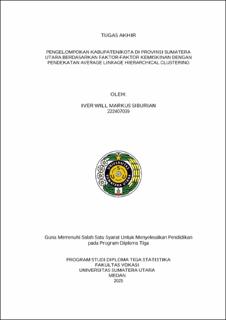| dc.description.abstract | Poverty remains one of the most pressing issues faced by many countries,
including Indonesia. This phenomenon is closely related to various other social
problems such as high unemployment rates, increased criminal activity, and social
inequality. This study aims to classify regencies/cities in North Sumatra Province
based on factors that influence poverty levels during the period of 2021 to 2023.
The analysis was conducted using the Average Linkage Hierarchical Clustering
method. The data used are secondary data obtained from the Central Statistics
Agency (BPS) for the years 2021–2023. The variables analyzed include the
percentage of the poor population, open unemployment rate (TPT), income, and
education level. The Average Linkage approach in cluster analysis was utilized to
construct a dendrogram and determine the optimal number of clusters based on
data patterns. The results of the analysis indicate that the regencies/cities in North
Sumatra can be classified into several clusters with similar poverty characteristics.
The average poverty rate was recorded at 10.44%, with a minimum value of
3.69% and a maximum of 24.66%. Additionally, other variables such as the
average net wage/salary of workers, open unemployment rate, and education level
show significant correlation with poverty levels. This study successfully identified
two main clusters. The second cluster reflects regions with relatively higher
poverty rates such as north Nias, west Nias, Nias, Pakpak Bharat, Gunung Sitoli,
Central Tapanuli, South Nias Samosir, North Tapanuli, Humbang Hasundutan,
South Tapanuli, Madailing Natal, Compared To regions in the first cluster. | en_US |


